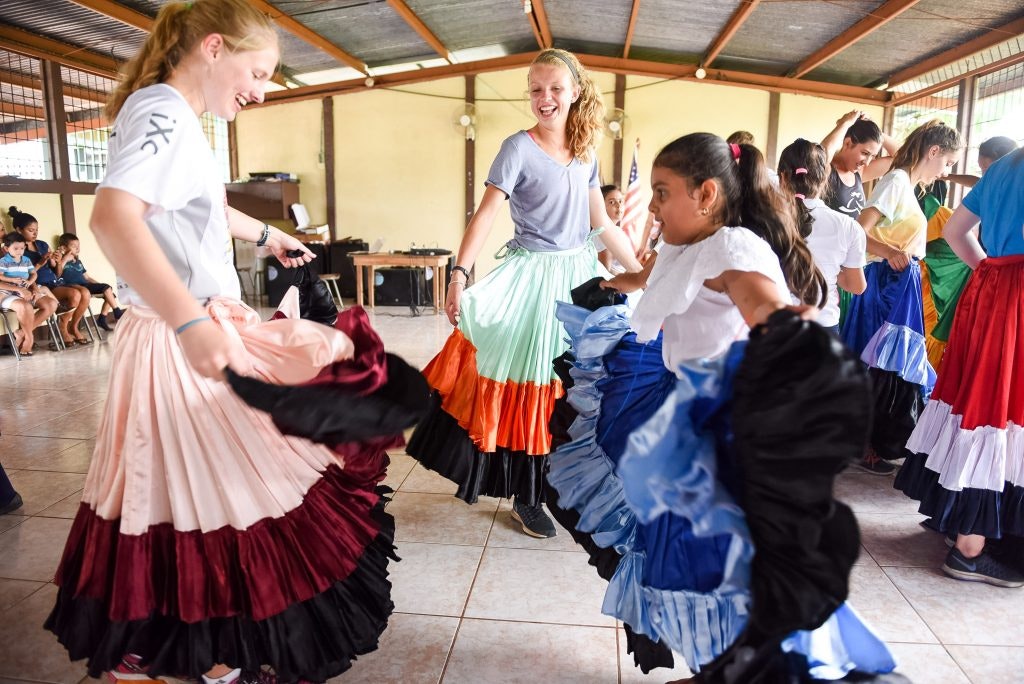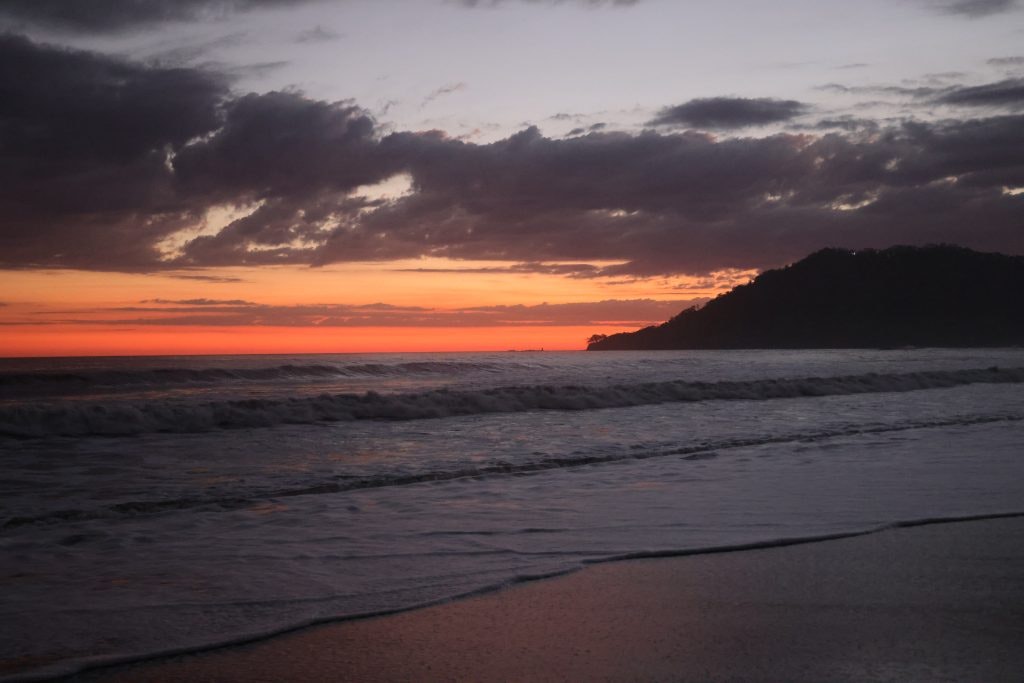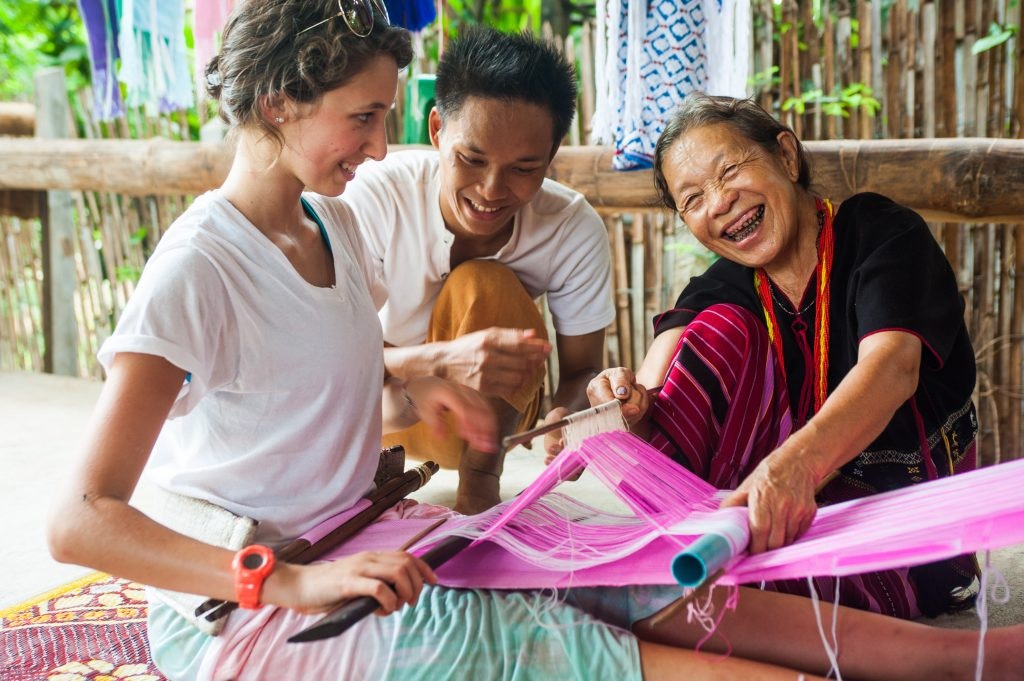







Every year ranking sites list the safest places to travel worldwide. Wealthy nations regularly top the travel safety list, including several European countries like Iceland or Denmark.

Children in Costa Rica teach Rustic Pathways students some traditional dances. Credit: Rustic Pathways
On other continents, Japan and Australia are in the top 15. These nations are good bets for teen travel, but they aren’t the only ones.
Many other destinations allow teens to safely experience non-Western cultures. They give students the opportunity to learn different languages, religions, traditions and lifestyles.
For 2025, our data shows a few non-Western nations are still popular choices for student travel. These countries have the best combination of safety, culture and adventure.
Key Takeaways
Iceland, Australia and Canada rank as the safest places to travel to in 2025, according to Berkshire Hathaway Travel Protection. Moreover, Germany, Japan and Portugal are among the safest nations for student travel.
Traveling to Germany means experiencing a mix of history, art and modern innovation at every turn. In Japan, you can explore its fascinating traditions with cutting-edge technology, providing students with unique learning opportunities in a country known for its politeness and low crime rates. Portugal stands out for its welcoming vibe, beaches and affordability, making it perfect for student groups looking for a fun and secure adventure.
Related: Safety Questions to Ask About Student Travel Programs
Based on our experience, Costa Rica and Thailand have consistently stood out as not only the most popular travel destinations but also as extremely safe. They’ve had that “hot spot” designation for some time. For years now, Rustic Pathways has hosted more students in Costa Rica than any other country. And Thailand ranks second in the number of enrollments.
Students in Thailand.
The 2024 Global Peace Index recognized Costa Rica as the most peaceful place in Latin America. Most crimes in the nation are petty crimes, like pickpocketing. Crime also tends to be concentrated in places students don’t go. This includes certain sections of the capital San Jose and the city Limón on the Caribbean coast.
On the healthcare front, Costa Rica is known for having high quality care. The World Health Organization previously ranked Costa Rica as the 36th best country in the world for healthcare.
This has helped boost life expectancy in Costa Rica. It’s higher in this Central American nation than the United States, according to the World Health Organization and the World Bank Group.
Fun fact: Costa Rica is known for its environmental sustainability initiatives. A focus on nature is a plus for travelers. It contributes to cleaner air and water. Unlike some other nations, you can drink the tap water in Costa Rica without fear.

Rustic Pathways helps save endangered sea turtles at this beautiful wildlife refuge in Costa Rica.
The pura vida – pure life – motto in the country creates a warm and welcoming culture. And the stunning landscapes in the nation make it a perfect oasis for travelers. These are among the reasons the Costa Rica regularly attracts student travelers. It’s a perfect choice for middle school, high school and college students who want a safe and adventurous destination.
Thailand also does well in the rankings on a number of fronts. Global Finance places Thailand one rank above the United States in safety. The U.S. State Department also lists Thailand as a country that is “Level-1: Exercise Normal Precautions.” This is the best safety ranking out of four options.
The country’s safety profile reassures travelers who want to head to Thailand for culture and adventure. In fact, Bangkok is now one of the most highly visited cities in the world. Throughout the country, the nation is called the Land of Smiles for a reason. It regularly is noted as being among the friendliest nations our students visit.

Joy is evident in Thailand, the Land of Smiles. Credit: Rustic Pathways
This welcoming nature makes it easier to address any problems that may arise. But there doesn’t seem to be many concerns. The most common safety issue may be hydration. A common mantra is, ”Remember to drink water.”
A hydrated and healthy traveler has a plethora of activity options in Thailand. Students can learn about Buddhism, visit historical sites and immerse in the culture. They can snorkel, hike and enjoy the sweeping landscapes. It’s an unforgettable journey for travelers.
But it takes time to pull together a program like this that’s safe and meaningful. Many factors are considered when fashioning programs for teen travel.
Safety tops the list when considering travel spots for teens. Because of that, only destinations with a good safety rating will be considered. Then having the right staff in place is crucial.
Rustic Pathways will only pick travel destination with strong local connection. Rustic’s country directors and program managers live in the nation where they’re planning trips. Many of them were born and raised in the areas where the students travel.
Rustic Pathways students get help from local experts who oversee service projects.
The local expertise allows Rustic to pick the best partners for both service and adventure. Local communities select service projects that fill a real need. These community partners provide much-needed guidance for students. They also ensure the right experts are on site. This may include plumbers and carpenters or botanists and wildlife technicians.
Our local Rustic staff also know the best vendors for adventure activities. As travel aficionados, they know the best spots for white water rafting, ziplining and other activities a program may include. They vet the vendors who provide these activities for safety and fun.
Once these pieces are in place, then a program may be added to the list. Once that program is added, a host of safety details must be addressed.
>> KEEP READING 4 Best Adventure Travel Programs for Thrill Seekers.
Let’s travel safe together.
Safety elements that are essential for a student travel program include:
Throughout all of this, the staff’s professional experience is crucial. Most of our country staff members are seasoned travel program experts who have managed everything from minor injuries like twisted ankles to more complex challenges such as anxiety. They’ve also helped with less common issues, like significant travel delays or adjusting the program for students with special needs.
The focus is always on the students. The key to safety is simple: ensuring students have the safest and most memorable experience possible. This passion for student safety fuels everything we do—and that’s what makes it all worthwhile.
Yes, Japan is one of the safest countries for tourists. It has a very low crime rate, efficient public transportation and a strong sense of public order. Visitors can feel secure walking around cities in Japan, even at night, thanks to the country’s well-maintained infrastructure and respect for laws.
Yes, Bali is generally considered a safe destination for travelers, with a well-established tourist infrastructure. However, like any popular travel spot, it is important to exercise caution in busy areas. Petty theft can occur, especially in crowded tourist locations, but overall, Bali is known for its welcoming atmosphere.
Countries like Syria, Afghanistan and South Sudan are not considered as safe for tourists. Those countries face political instability and armed conflict, tend to be rated as some of the most unsafe places to visit. These regions struggle with high crime rates and lack of infrastructure, posing significant risks to travelers.
Copenhagen, Tokyo and Singapore are often cited as the safest cities in the world. These cities boast low crime rates, excellent public services, and a high standard of living. The well-organized infrastructure and sense of order in these cities contribute to their safety rankings.
Singapore is often considered the safest country in Asia, with its low crime rate, strict laws and efficient public services. Other safe Asian countries include Japan and South Korea, which also boast low crime rates and high standards of living.